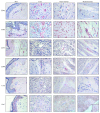Mesenchymal Stromal Cells and Tissue-Specific Progenitor Cells: Their Role in Tissue Homeostasis
- PMID: 26823669
- PMCID: PMC4707334
- DOI: 10.1155/2016/4285215
Mesenchymal Stromal Cells and Tissue-Specific Progenitor Cells: Their Role in Tissue Homeostasis
Abstract
Multipotent mesenchymal stromal/stem cells (MSCs) reside in many human organs and comprise heterogeneous population of cells with self-renewal ability. These cells can be isolated from different tissues, and their morphology, immunophenotype, and differentiation potential are dependent on their tissue of origin. Each organ contains specific population of stromal cells which maintain regeneration process of the tissue where they reside, but some of them have much more wide plasticity and differentiate into multiple cells lineage. MSCs isolated from adult human tissues are ideal candidates for tissue regeneration and tissue engineering. However, MSCs do not only contribute to structurally tissue repair but also MSC possess strong immunomodulatory and anti-inflammatory properties and may influence in tissue repair by modulation of local environment. This paper is presenting an overview of the current knowledge of biology of tissue-resident mesenchymal stromal and progenitor cells (originated from bone marrow, liver, skeletal muscle, skin, heart, and lung) associated with tissue regeneration and tissue homeostasis.
Figures

References
-
- Meirelles Lda S., Nardi N. B. Methodology, biology and clinical applications of mesenchymal stem cells. Frontiers in Bioscience. 2009;14:4281–4298. - PubMed
Publication types
LinkOut - more resources
Full Text Sources
Other Literature Sources

